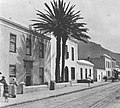Arthur Elliott (photographer)
South African photographer From Wikipedia, the free encyclopedia
Arthur Elliott (1870, New York City – 20 November 1938, Cape Town), was an American born South African photographer who recorded the architecture and daily life of the Cape. Elliott took over 10,000 photographs of Cape Dutch architecture, creating an unrivalled pictorial record of early 20th century buildings at the Cape.[1][2][3]
Arthur Elliott | |
|---|---|
 Arthur Elliott self-portrait | |
| Born | 1870 |
| Died | 20 November 1938 (aged 75–76) |
| Occupation | photographer |
| Years active | 1900-1930 |
| Known for | architectural & street photography |
Life

Imhoff's Gift
House built on the farm Noordhoek given by Baron Gustav Wilhelm van Imhoff to the widow Christina RousseauElliott was born in New York City in 1870.[4] He was orphaned at 12 years old and lived in England and India before arriving in South Africa at the age of 30.[5] He tried his hand at various jobs such as scene-painter and production manager at the Luscombe Searelle Acting Company in Johannesburg.[6][7]
Elliott died in Cape Town on November 30, 1938.[8]
Work
Summarize
Perspective
Elliott ended up in Cape Town as a war refugee in 1900 and took to photography, which became a life passion.[5] His home in Cape Town is commemorated by a plaque at 134 Long Street.[9][10] He had a number of major exhibitions in Cape Town ; in 1910, 1913 (with a catalogue compiled by Theal and F.K. Kendall's article on Cape architecture), in 1926 (with an introduction by Sir George Cory, the historian),[11][12] another in 1930, arranged by W.R. Morrison.[13] His final exhibition, in 1938, was titled "The Cape, Quant and Beautiful” and included a catalogue edited by Victor de Kockin.[14] These gave him widespread recognition and enabled him to eke out a living through the selling of prints.
Elliott seems to have been determined to record as much as he was able of the old farmhouses, buildings and streets that were rapidly disappearing with the ever-growing pressure to modernize. During his lifetime only a portfolio of some of his images was published for the use of schools, but in 1969 he authored selection of his best images, showing farmsteads and historic buildings, with an introduction and annotations by Hans Fransen.[15] Before his death, Elliott offered his collection of photographs to the local government for £5000; the offer was declined.[16] After his death, his collection was acquired by the Government and presented to the Cape Archives.[2] A further 1,000 photographs from the collection of W.R. Morrison were added later. The Elliott Collection, as his set of images came to be called, has been used extensively by authors writing about all aspects of old Cape architecture.[17][18]
Gallery of work
- Alphen, 18th century farmhouse
- Cottage at Bishopscourt
- Rhone House, Stellenbosch
- The Palm Tree Mosque, 1915
- Two children outside the tomb of Sheik Yusuf
- Main Street, Swellendam at the turn of the 20th century
- Jonkershuis, Groot-Constantia
Bibliography
- Laidler, P. W. Arthur Elliott, a Sentimental Appreciation. Cape Town.
- Lighton, C. Arthur Elliott; a Memoir of the Man and the Story of his Photographic Collection. Cape Town, 1956.[19]
- Architectural Beauty of the Cape as seen by Arthur Elliott – Hans Fransen (Balkema, Cape Town 1969)
References
Wikiwand - on
Seamless Wikipedia browsing. On steroids.







